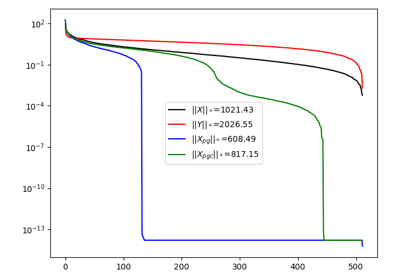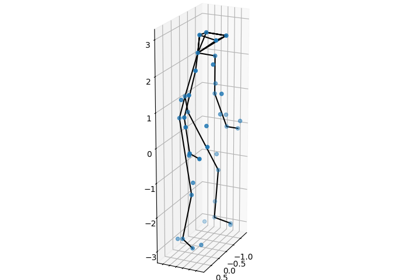pyproximal.Nuclear#
- class pyproximal.Nuclear(dim, sigma=1.0)[source]#
Nuclear norm proximal operator.
The nuclear norm is defined as \(\sigma\|\mathbf{X}\|_* = \sigma \sum_i \lambda_i\) where \(\mathbf{X}\) is a matrix of size \(M \times N\) and \(\lambda_i\) is the i:th singular value of \(\mathbf{X}\), where \(i=1,\ldots, \min(M, N)\).
The weighted nuclear norm, with the positive weight vector \(\boldsymbol\sigma\), is defined as
\[\|\mathbf{X}|\|_{{\boldsymbol\sigma},*} = \sum_i \sigma_i\lambda_i(\mathbf{X}) .\]- Parameters
- dim
tuple Size of matrix \(\mathbf{X}\)
- sigma
floatornumpy.ndarray, optional Multiplicative coefficient of the nuclear norm penalty. If
sigmais a float the same penalty is applied for all singular values. If insteadsigmais an array the weightsigma[i]will be applied to the i:th singular value. This is often referred to as the weighted nuclear norm.
- dim
Notes
The nuclear norm proximal operator is:
\[\prox_{\tau \sigma \|\cdot\|_*}(\mathbf{X}) = \mathbf{U} \diag \{ \prox_{\tau \sigma \|\cdot\|_1}(\boldsymbol\lambda) \} \mathbf{V}^H\]where \(\mathbf{U}\), \(\boldsymbol\lambda\), and \(\mathbf{V}\) define the SVD of \(X\).
The weighted nuclear norm is convex if the sequence \(\{\sigma_i\}_i\) is non-ascending, but is in general non-convex; however, when the weights are non-descending it can be shown that applying the soft-thresholding operator on the singular values still yields a fixed point (w. r. t. a specific algorithm), see [1] for details.
- 1
Gu et al. “Weighted Nuclear Norm Minimization with Application to Image Denoising”, In the IEEE Conference on Computer Vision and Pattern Recognition, 2862-2869, 2014.
Methods
__init__(dim[, sigma])affine_addition(v)Affine addition
chain(g)Chain
grad(x)Compute gradient
postcomposition(sigma)Postcomposition
precomposition(a, b)Precomposition
prox(**kwargs)proxdual(**kwargs)


